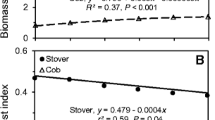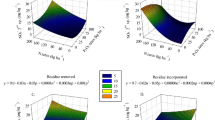Abstract
Corn stover removal for biofuels production removes potentially recyclable nutrients and carbon challenging the sustainability of the process. Therefore, this study focused on quantifying the distributions of dry matter, nitrogen, phosphorus, potassium, carbon, sugars and lignin in corn stover fractions, and cobs. In 2016 and 2017, corn plants from different hybrids were collected from a corn field in Ohio at two maturity levels. The properties were evaluated for different non-grain corn plant fractions (i.e., stover fractions above and below ear, and cob). Stover fractions below and above ear (not including cobs) and cobs contributed, respectively, to 42–56%, 31–38%, and 13–18% of the total non-grain aboveground dry matter in 2 years. Glucose and lignin concentrations were uniformly distributed and ranged from 321 to 407 mg/g and 87 to 158 mg/g, respectively, for both years. Cobs contained the highest concentration of other sugars (351–361 mg/g) in both years, compared to 217–298 mg/g in other fractions. Nitrogen and phosphorus were uniformly distributed across the different corn stover and cob fractions, ranging between 4–20 mg/g and 0.2–1.5 mg/g, respectively. Potassium concentration was the highest in stover fraction below ear (10–24 mg/g) compared to 5–11 mg/g in other fractions. The results suggest that harvesting cob and above ear stover fractions from the field would allow corn stover collection with suitable sugar concentrations for biofuels/products while retaining stover fractions with higher nutrients concentrations in the field.

Similar content being viewed by others
References
U.S. EPA (2017) Overview for renewable fuel standard. https://www.epa.gov/renewable-fuel-standard-program/overview-renewable-fuel-standard. Accessed 29 May 2018
Schwab A, Warner E, Lewis J (2016) 2015 Survey of non-starch ethanol and renewable hydrocarbon biofuels producers. https://www.nrel.gov/docs/fy16osti/65519.pdf. Accessed 3 May 2019
U.S. DOE (2016) 2016 Billion-Ton Report. https://www.energy.gov/sites/prod/files/2016/12/f34/2016_billion_ton_report_12.2.16_0.pdf. Accessed 16 Dec 2018
Iowa Corn Promotion Board (2013) Sustainable Corn Stover Harvest. https://www.iowacorn.org/media/cms/IowaCornResearchBrochure_Final_IFT_F4B608A12ED16.pdf. Accessed 10 Mar 2019
Arora K, Licht M, Leibold K (2014) Industrial corn stover harvest. In: Iowa State Univ. Ext. Outreach. https://store.extension.iastate.edu/product/Industrial-Corn-Stover-Harvest. Accessed 10 Mar 2019
Shah A, Darr M, Khanal S, Lal R (2016) A techno-environmental overview of a corn stover biomass feedstock supply chain for cellulosic biorefineries. Biofuels:1–11
Lal R (2009) Soil quality impacts of residue removal for bioethanol production. Soil Tillage Res 102:233–241. https://doi.org/10.1016/j.still.2008.07.003
Wilhelm WW (2004) Crop and soil productivity response to corn residue removal: a literature review. Agron J 96(1):17. https://doi.org/10.2134/agronj2004.0001
Adler PR, Rau BM, Roth GW (2015) Sustainability of corn stover harvest strategies in Pennsylvania. Bioenergy Res 8:1310–1320. https://doi.org/10.1007/s12155-015-9593-2
Hoskinson RL, Karlen DL, Birrell SJ et al (2007) Engineering, nutrient removal, and feedstock conversion evaluations of four corn stover harvest scenarios. Biomass Bioenergy 31:126–136. https://doi.org/10.1016/j.biombioe.2006.07.006
Mourtzinis S, Cantrell KB, Arriaga FJ, Balkcom KS, Novak JM, Frederick JR, Karlen DL (2016) Carbohydrate and nutrient composition of corn stover from three southeastern USA locations. Biomass Bioenergy 85:153–158. https://doi.org/10.1016/j.biombioe.2015.11.031
Johnson JMF, Wilhelm WW, Karlen DL, Archer DW, Wienhold B, Lightle DT, Laird D, Baker J, Ochsner TE, Novak JM, Halvorson AD, Arriaga F, Barbour N (2010) Nutrient removal as a function of corn stover cutting height and cob harvest. Bioenergy Res 3:342–352. https://doi.org/10.1007/s12155-010-9093-3
Karlen DL, Kovar JL, Birrell SJ (2015) Corn r nutrient removal estimates for Central Iowa, USA. Sustain 7:8621–8634. https://doi.org/10.3390/su7078621
Cruse RM, Herndl CG (2009) Balancing corn stover harvest for biofuels with soil and water conservation. J Soil Water Conserv 64:286–291. https://doi.org/10.2489/jswc.64.4.286
Jeschke M, Heggenstaller A (2012) Sustainable corn stover harvest for biofuel production. Crop Insights 22:1–6
Chen H, Li X, Hu F, Shi W (2013) Soil nitrous oxide emissions following crop residue addition: a meta-analysis. Glob Chang Biol 19:2956–2964. https://doi.org/10.1111/gcb.12274
Jin VL, Baker JM, Johnson JMF, Karlen DL, Lehman RM, Osborne SL, Sauer TJ, Stott DE, Varvel GE, Venterea RT, Schmer MR, Wienhold BJ (2014) Soil greenhouse gas emissions in response to corn stover removal and tillage management across the US Corn Belt. Bioenergy Res 7:517–527. https://doi.org/10.1007/s12155-014-9421-0
Congreves KA, Brown SE, Németh DD, Dunfield KE, Wagner-Riddle C (2017) Differences in field-scale N2O flux linked to crop residue removal under two tillage systems in cold climates. GCB Bioenergy 9:666–680. https://doi.org/10.1111/gcbb.12354
Graham RL, Nelson R, Sheehan J, Perlack RD, Wright LL (2007) Current and potential U.S. corn stover supplies. Agron J 99(1):11. https://doi.org/10.2134/agronj2005.0222
Nafziger ED (2011) Tillage and nitrogen responses to residue removal in continuous corn. In: North central extension-industry soil fertility conference. International Plant Nutrition Institute, Des Moines, pp 16–19
Blanco-Canqui H, Lal R (2007) Soil and crop response to harvesting corn residues for biofuel production. Geoderma 141:355–362. https://doi.org/10.1016/j.geoderma.2007.06.012
Wilhelm WW, Johnson JMF, Karlen DL, Lightle DT (2007) Corn stover to sustain soil organic carbon further constrains biomass supply. Agron J 99:1665–1667. https://doi.org/10.2134/agronj2007.0150
Mann L, Tolbert V, Cushman J (2002) Potential environmental effects of corn (Zea mays L.) stover removal with emphasis on soil organic matter and erosion. Agric Ecosyst Environ 89:149–166. https://doi.org/10.1016/S0167-8809(01)00166-9
Blanco-Canqui H, Lal R (2009) Corn stover removal for expanded uses reduces soil fertility and structural stability. Soil Sci Soc Am J 73:418. https://doi.org/10.2136/sssaj2008.0141
Wang S, Wang Y, Cai Q, Wang X, Jin H, Luo Z (2014) Multi-step separation of monophenols and pyrolytic lignins from the water-insoluble phase of bio-oil. Sep Purif Technol 122:248–255. https://doi.org/10.1016/j.seppur.2013.11.017
Johnson J, Novak J, Varvel G et al (2014) Crop residue mass needed to maintain soil organic carbon levels: can it be determined? Bioenergy Res 7:481–490. https://doi.org/10.1007/s12155-013-9402-8
Wilhelm WW, Johnson JMF, Lightle DT, Karlen DL, Novak JM, Barbour NW, Laird DA, Baker J, Ochsner TE, Halvorson AD, Archer DW, Arriaga F (2011) Vertical distribution of corn stover dry mass grown at several US locations. Bioenergy Res 4:11–21. https://doi.org/10.1007/s12155-010-9097-z
Karlen DL, Birrell SJ, Johnson JMF, Osborne SL, Schumacher TE, Varvel GE, Ferguson RB, Novak JM, Fredrick JR, Baker JM, Lamb JA, Adler PR, Roth GW, Nafziger ED (2014) Multilocation corn stover harvest effects on crop yields and nutrient removal. BioEnergy Res 7:528–539. https://doi.org/10.1007/s12155-014-9419-7.Rights
Ye X, Liu S, Kline L, et al (2006) Fast biomass compositional analysis using Fourier Transform Near-infrared Technique 2006 ASABE Annu Int Meet 0300:1–10
Barten TJ (2013) Evaluation and prediction of corn stover biomass and composition from commercially available corn hybrids. Iowa State Unviersity, Ames
Templeton DW, Sluiter AD, Hayward TK, Hames BR, Thomas SR (2009) Assessing corn stover composition and sources of variability via NIRS. Cellulose 16:621–639. https://doi.org/10.1007/s10570-009-9325-x
Weiss ND, Farmer JD, Schell DJ (2010) Impact of corn stover composition on hemicellulose conversion during dilute acid pretreatment and enzymatic cellulose digestibility of the pretreated solids. Bioresour Technol 101:674–678. https://doi.org/10.1016/j.biortech.2009.08.082
Gao P, Fan D, Luo Y et al (2009) Efficient and comprehensive utilization of hemicellulose in the corn stover. Chin J Chem Eng 17:350–354. https://doi.org/10.1016/S1004-9541(08)60215-3
Duguid KB, Montross MD, Radtke CW, Crofcheck CL, Wendt LM, Shearer SA (2009) Effect of anatomical fractionation on the enzymatic hydrolysis of acid and alkaline pretreated corn stover. Bioresour Technol 100:5189–5195. https://doi.org/10.1016/j.biortech.2009.03.082
Mourtzinis S, Cantrell KB, Arriaga FJ, Balkcom KS, Novak JM, Frederick JR, Karlen DL (2014) Distribution of structural carbohydrates in corn plants across the southeastern USA. Bioenergy Res 7:551–558. https://doi.org/10.1007/s12155-014-9429-5
Aboagye D, Banadda N, Kambugu R, Seay J, Kiggundu N, Zziwa A, Kabenge I (2017) Glucose recovery from different corn stover fractions using dilute acid and alkaline pretreatment techniques. J Ecol Environ 41:1–11. https://doi.org/10.1186/s41610-017-0044-1
Garlock RJ, Chundawat SPS, Balan V, Dale BE (2009) Optimizing harvest of corn Stover fractions based on overall sugar yields following ammonia fiber expansion pretreatment and enzymatic hydrolysis. Biotechnol Biofuels 2:1–14. https://doi.org/10.1186/1754-6834-2-29
Ding JC, Xu GC, Han RZ, Ni Y (2016) Biobutanol production from corn stover hydrolysate pretreated with recycled ionic liquid by Clostridium saccharobutylicum DSM 13864. Bioresour Technol 199:228–234. https://doi.org/10.1016/j.biortech.2015.07.119
Wang L, Chen H (2011) Increased fermentability of enzymatically hydrolyzed steam-exploded corn stover for butanol production by removal of fermentation inhibitors. Process Biochem 46:604–607. https://doi.org/10.1016/j.procbio.2010.09.027
Zhang Y, Hou T, Li B, Liu C, Mu X, Wang H (2013) Acetone-butanol-ethanol production from corn stover pretreated by alkaline twin-screw extrusion pretreatment. Bioprocess Biosyst Eng 37:913–921. https://doi.org/10.1007/s00449-013-1063-7
He T, Jiang Z, Wu P, Yi J, Li J, Hu C (2016) Fractionation for further conversion: from raw corn stover to lactic acid. Sci Rep 6:1–11. https://doi.org/10.1038/srep38623
Nichols NN, Saha BC (2016) Production of xylitol by a Coniochaeta ligniaria strain tolerant of inhibitors and defective in growth on xylose. Biotechnol Prog 32:606–612. https://doi.org/10.1002/btpr.2259
Chen H (2014) Chemical composition and structure of natural lignocellulose. In: Biotechnology of lignocellulose: theory and practice. Chemical Industry Press, Beijing, pp 25–71
Johnson J, Karlen D, Gresham G, Cantrell K, Archer D, Wienhold B, Varvel G, Laird D, Baker J, Ochsner T, Novak J, Halvorson A, Arriaga F, Lightle D, Hoover A, Emerson R, Barbour N (2014) Vertical distribution of structural components in corn stover. Agriculture 4:274–287. https://doi.org/10.3390/agriculture4040274
SAS Institute (2011) SAS. https://www.sas.com/en_us/software/university-edition/download-software.html. Accessed 2 Dec 2018
Clewer AG, Scarisbrick DH (2001) Practical statistics and experimental design for plant and crop science. Wiley, Chichester
Pennington D (2013) Harvest index: a predictor of corn stover yield. In: Michigan State Univ. Ext. https://www.canr.msu.edu/news/harvest_index_a_predictor_of_corn_stover_yield. Accessed 2 Dec 2018
Sluiter A, Hames B, Ruiz R, et al (2012) NREL/TP-510-42618 analytical procedure - determination of structural carbohydrates and lignin in biomass. Lab Anal Proced 17. NREL/TP-510-42618
Gonick H, Tunnicliff DD, Peters ED, Lykken L, Zahn V (1945) Determination of nitrogen by combustion improved dumas apparatus and recycle procedure. Ind Eng Chem Anal Ed 17:677–682. https://doi.org/10.1021/i560147a001
US EPA (2007) Microwave assisted acid digestion of sediments, sludges, soils and oils. https://www.epa.gov/sites/production/files/2015-12/documents/3051a.pdf. Accessed 16 Dec 2018
Wu Y, Liu S, Young CJ, Dahal D, Sohl TL, Davis B (2015) Projection of corn production and stover-harvesting impacts on soil organic carbon dynamics in the US. Temperate Prairies. Sci Rep 5:1–12. https://doi.org/10.1038/srep10830
Faulkner DB, Berger LL, Eckhoff SR (2012) Harvest date influence on dry matter yield and moisture of corn and stover. Trans ASABE 55:593–598
Balan V (2014) Current challenges in commercially producing biofuels from lignocellulosic biomass. ISRN Biotechnol 2014:1–31. https://doi.org/10.1155/2014/463074
Cambouris AN, Ziadi N, Perron I, Alotaibi KD, St. Luce M, Tremblay N (2016) Corn yield components response to nitrogen fertilizer as a function of soil texture. Can J Soil Sci 96:386–399. https://doi.org/10.1139/cjss-2015-0134
Ren B, Dong S, Zhao B, Liu P, Zhang J (2017) Responses of nitrogen metabolism, uptake and translocation of maize to waterlogging at different growth stages. Front Plant Sci 8:1–9. https://doi.org/10.3389/fpls.2017.01216
Li HY, Xu L, Liu WJ, Fang MQ, Wang N (2014) Assessment of the nutritive value of whole corn stover and its morphological fractions. Asian Australas J Anim Sci 27:194–200. https://doi.org/10.5713/ajas.2013.13446
Hanway JJ (1966) How a corn plant develops. https://lib.dr.iastate.edu/cgi/viewcontent.cgi?article=1045&context=specialreports. Accessed 2 Dec 2018
Sawyer J (2007) Nutrient removal when harvesting corn stover. In: Iowa State Univ. Ext. Outreach. https://crops.extension.iastate.edu/nutrient-removal-when-harvesting-corn-stover-0. Accessed 16 Dec 2018
Barbosa JZ, Ferreira CF, dos Santos NZ et al (2016) Production, carbon and nitrogen in stover fractions of corn (Zea mays L.) in response to cultivar development. Ciência e Agrotecnol 40:665–675. https://doi.org/10.1590/1413-70542016406020316
Latshaw WL, Miller EC (1924) Elemental composition of the corn plant. J Agric Res 27:845–861
Funding
This work was supported by funding from USDA NIFA AFRI Foundational Program (Grant No. 2017-67021-26141) and USDA NIFA Hatch Project (Grant No. 1005665).
Author information
Authors and Affiliations
Corresponding author
Additional information
Publisher’s Note
Springer Nature remains neutral with regard to jurisdictional claims in published maps and institutional affiliations.
Electronic supplementary material
ESM 1
(DOCX 38 kb)
Rights and permissions
About this article
Cite this article
Khanal, A., Manandhar, A. & Shah, A. Physicochemical and Structural Characteristics of Corn Stover and Cobs After Physiological Maturity. Bioenerg. Res. 12, 536–545 (2019). https://doi.org/10.1007/s12155-019-09992-7
Published:
Issue Date:
DOI: https://doi.org/10.1007/s12155-019-09992-7




